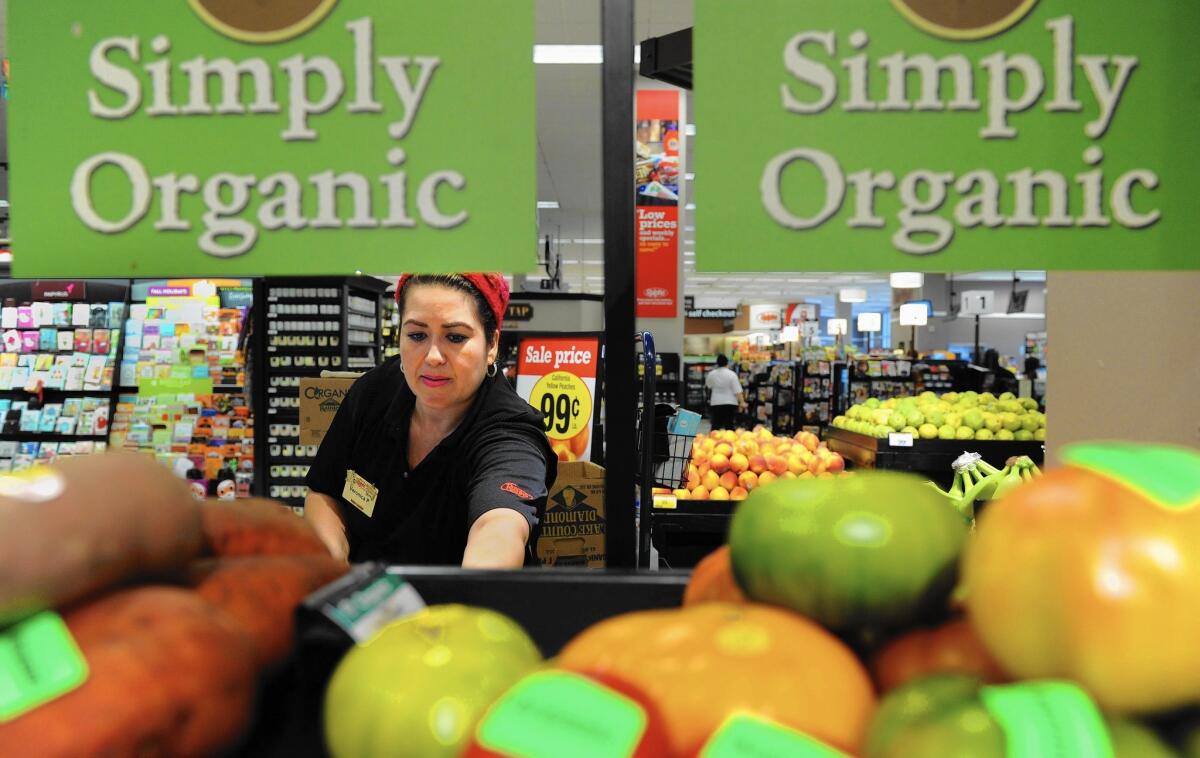For grocers, Southern California is an irresistible—and cutthroat—market

The bold Southern California expansion by tiny grocery Haggen Inc., and the company’s abrupt bankruptcy filing only six months after opening its first store in the region, came as little surprise to Jack Brown.
Brown is the longtime chief executive of the 168-store Stater Bros. chain, based in San Bernardino, and he’s seen the rise and fall of many supermarkets since his entry into the business as a teenage box boy. Now 77, Brown even keeps a list of the chains that have disappeared — once-familiar names such as Lucky, Alpha Beta and Mayfair.
“I have seen everything in the food industry come and go in Southern California,” he said.
But as the Haggen bankruptcy filing last week illustrated, Brown and the rest of the industry are seeing a fresh flurry of activity among rival stores that has roiled a Southern California grocery business that already is “arguably the most competitive in the country,” said Ron Johnston, who publishes the industry-tracking Shelby Report.
In addition to Haggen, Fresh & Easy closed 30 stores in Southern California after an ill-fated effort in the region. Stalwart grocers Albertsons and Safeway, which also own Vons and Pavilions, merged into one company to better compete against market leader Ralphs and others.
Discount food chains Aldi and Grocery Outlet Bargain Market plan new stores in the area. Whole Foods intends to open the first of its value-oriented stores, called 365, in Los Angeles next year.
Why do new entrants keep arriving despite the stiff competition and the troubles experienced by Haggen and others? Because Southern California’s $44 billion in annual grocery sales makes it the largest U.S. grocery market by far, and that’s a near-irresistible lure, Johnston said.
The market’s enormous size also is why big-box discount retailers such as Wal-Mart Stores Inc., Target Corp. and Costco Wholesale Corp. have expanded their grocery offerings in the last decade. It’s also why specialty grocers, such as Whole Foods and Trader Joe’s, have thrived alongside the conventional supermarket chains.
And while the grocers are battling one another, they’re all hustling to stay abreast of major cultural shifts affecting consumers’ buying habits. Shoppers want more healthful foods, more ethnic groceries and added convenience.
“It used to be that there was a gluten-free section in one part of the store and 10 products in that section,” Ralphs spokeswoman Kendra Doyel said. Now gluten-free versions of various products are found throughout the store as “these trends become more mainstream,” she said.
Southern California’s diverse culture is driving the greater emphasis on ethnic foods. Unified Grocers Inc. in the City of Commerce, a wholesale cooperative with $3.8 billion in annual sales that mainly serves independent stores, has a division devoted to supplying Latino, Asian and other ethnic foods.
And e-commerce leaders Amazon Inc. and Google Inc. are trying to exploit consumers’ desire for convenience by ramping up grocery-delivery services.
Add it all up and “it’s such a fluid market at the moment,” said Johnston, who hasn’t updated his figures on the grocers’ market shares in Southern California since May because “there’s been so much activity” among the competitors.
Those data have Ralphs leading the Southern California market with 368 stores and nearly 19% of the region’s grocery sales. Vons and Pavilions were second with 267 stores and 15% of sales.
The supermarkets know that Southern California consumers have no qualms about shopping at different chains, even if they have discount-rewards cards with their local grocer and even if it means paying a bit more or driving a bit farther.
“I shop close to my house usually, but I will go further out for better meat and a better selection of organic [foods],” Myisha Jones, 36, of Monterey Park said while shopping at a Ralphs in downtown Los Angeles.
Part of that flexibility dates to a labor dispute that involved Ralphs, Vons and Albertsons in 2003-04. As the strike and lockout dragged on for 4 1/2 months, many of the three chains’ shoppers took their business elsewhere, costing the chains a combined $1.5 billion in lost sales and permanently shifting some consumers’ store loyalties.
Sonya Hernandez, 32, of South Pasadena stopped shopping at Ralphs or Vons because, in her view, the labor dispute hurt the workers. “Ever since the strike, we really don’t go to them,” she said during a stop at Whole Foods in Pasadena.
Overall, Southern California now has “a demanding population because if they don’t like Chain A, they can go to Chain B or Chain C,” said Stater Bros.’ Brown. “They have a lot of choices today.”
Because so many consumers commute lengthy distances for work, they’re also not tied to shopping only at the markets nearest their homes, Brown said.
“We know people who pull off the freeway going home, shop at a Stater’s and then drive home,” he said. “Time is very important in Southern California.”
The region’s major chains, led by Kroger Co.’s Ralphs, constantly compete on price, service and the convenience of their stores. Those price battles are a key reason grocery stores typically have notoriously small profit margins of 1% to 2%; that is, they earn only a penny or two of profit on each dollar of sales.
Price competition is especially acute “because the cost of living is so high in California,” said Burt Flickinger III, an industry analyst at consulting firm Strategic Resource Group. “Consumers in Southern California need to save more money on groceries than just about anywhere in the continental U.S.”
One is Dorothy Jones, 39, of West Los Angeles, who scans her weekly supermarket circulars and plans her weekly shopping based on the sales. “Sometimes I’ll go to more than one store in a day,” she said.
Leon Braiman, 68, of West Hollywood said that nine months ago he switched to the Super King Market in northeast Los Angeles from Ralphs and Vons because of lower prices. “It’s 10 minutes further from my home but you don’t have to go from one store to another” to save money, he said.
Price isn’t always the sole factor in consumer preferences, of course. Some are willing to pay more for organic and other specialty products at Whole Foods and Trader Joe’s, for instance.
But consumers’ desire to keep food costs in check is one reason Whole Foods is rolling out its lower-priced 365 division. And price appeared to be a factor in Haggen’s problems, with some shoppers griping that the chain charged more than the stores it replaced.
Haggen jumped headlong into Southern California early this year by purchasing 146 Albertsons, Vons, Pavilions and Safeway stores that U.S. regulators required to be sold in order to approve the Albertsons-Safeway merger.
The stores included 83 in California, mostly in the southern part of the state, but Haggen already has announced plans to close 27 of them and lay off employees as it acknowledged “unprecedented” competition in the U.S. Southwest. A Haggen spokeswoman said that executives weren’t available to discuss the company’s travails.
The German discount Aldi chain, which already has 1,400 locations in 32 states, hopes to fare better than Haggen when it opens the first of 45 stores in Southern California in March. If Aldi succeeds, the company could put added downward pressure on prices in the region.
“There is no other place with the same density of people that exists in Southern California,” Jason Hart, Aldi’s CEO for U.S. operations, told The Times in June. “It’s an important market with really big potential for us.”
It’s also a treacherous market for stores that don’t find the right combination of price, products and service. Just ask Haggen, or check Jack Brown’s list.
Twitter: @PeltzLATimes
Twitter: @ByShanLi
ALSO:
After heat wave, rain on the way to Southern California
Legislature sends marijuana regulations to Gov. Brown
Aggressive treatment of high blood pressure pays off for patients, study finds








